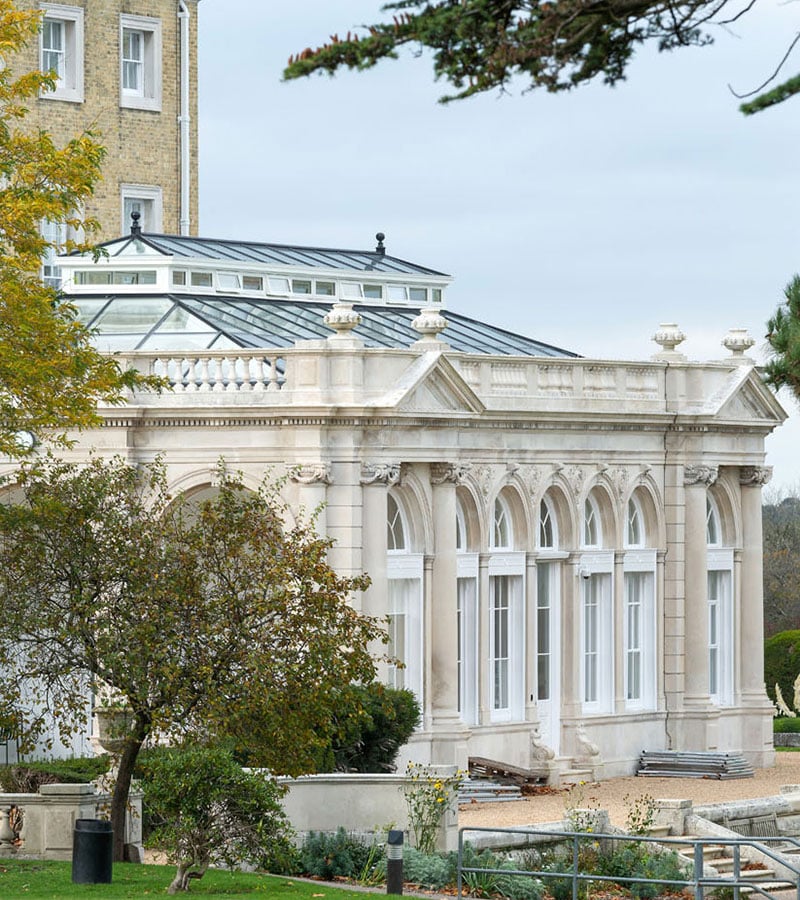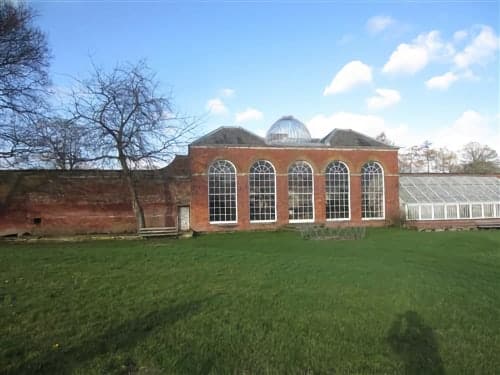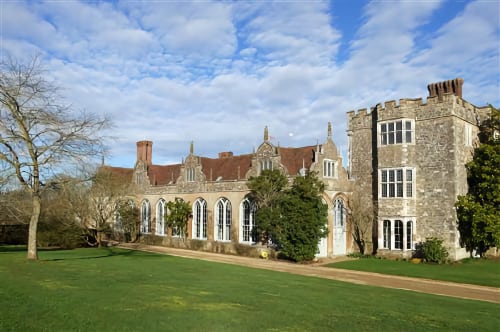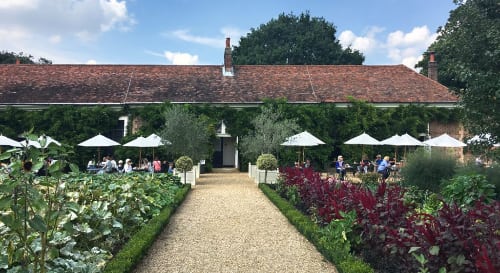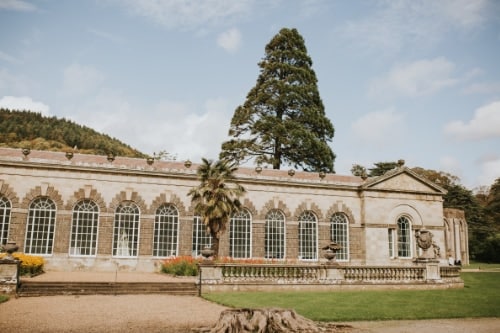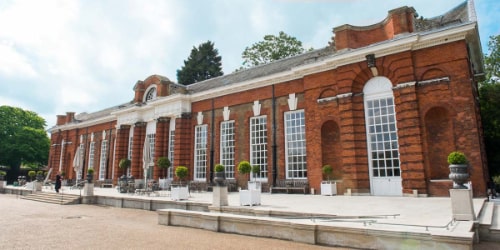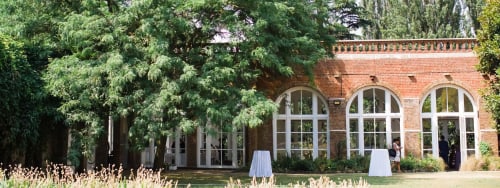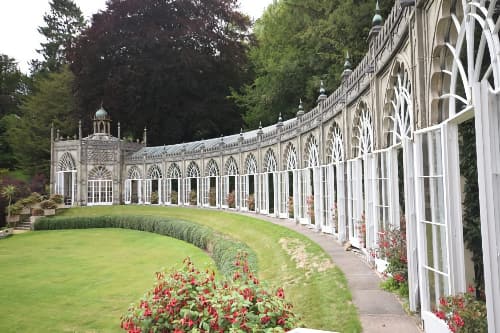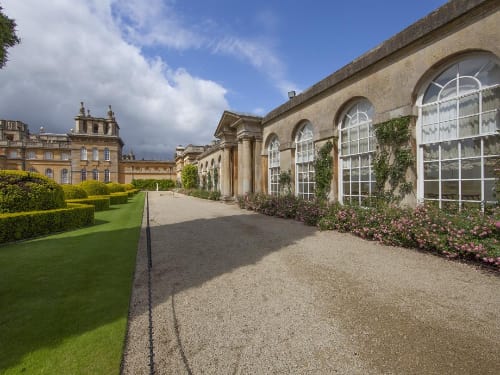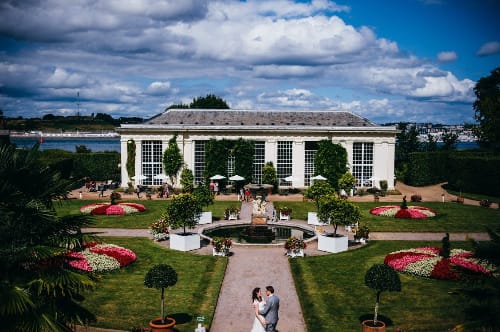Orangeries were once a sign of wealth and prestige, built to house citrus plants throughout the harsh winter months. In the modern day, an orangery is a popular choice of glazed extension for many homeowners, but curating the right design for your property’s style and your lifestyle can prove a challenge. We’ve compiled a list of 10 incredible orangery examples from all over the UK that you can visit for some design inspiration, or just for a fun day out, full of architectural history.
1. National Trust, Calke Abbey – Derbyshire
The Orangery at Calke Abbey dates back to between the 18th and 19th centuries. Its walls are composed of mostly brick and it is surrounded by garden walls, also dating back to a similar time. The orangery faced periods of neglect and disuse, however, in the late 20th century, the National Trust acquired Calke Abbey. Careful restoration and renovation of the orangery were undertaken, reclaiming its former glory and charm.
Now, the orangery has been transformed into a visitor centre, welcoming guests and providing information about the estate’s history and the surrounding area. Additionally, it offers a delightful tearoom where visitors can indulge in refreshments and savour the tranquil surroundings. This is just one of many National Trust country estates that incorporate an orangery.
2. National Trust, Knole – Kent
The origins of this orangery remain somewhat unclear, but its believed to have been constructed in the early 17th century, located alongside Knole House, a magnificent mansion. The structure was renovated in 1823, removing the ceiling between the ground and first floor to make space for a series of double-height windows with a matching set of doors. Its oak roof is composed of nine trusses.
In the present day, The Orangery at Knole is a versatile space, serving as a venue for a range of events. Its fascinating architecture and scenic surroundings make it a sought-after location for special occasions. As part of the National Trust’s efforts to preserve the heritage of Knole, the orangery is also open to the public, allowing visitors to experience its elegant interior and craftsmanship.
3. National Trust, Ham House – Surrey
This final National Trust orangery on our list is a fascinating historical structure situated within the grounds of Ham House, a 17th-century mansion. The structure is believed to have been constructed around the 1670s and is one of the earliest examples of an orangery, with its style recalling Dutch classical architecture. As the years passed, The Orangery at Ham House began to serve as a space for entertaining guests, hosting elegant social gatherings, and displaying valuable works of art.
The orangery is now used as a café and serves fresh produce from the surrounding gardens. For a historic day out that is fit for the whole family, visit the Ham House grounds, stop for a drink and some cake in the orangery, and pass through the gift shop and second-hand book shop on your way out.
4. Kew Gardens – London
The Orangery at Kew Gardens is a remarkable structure built in 1761 to house citrus trees, however even with the addition of two side windows in 1842, the light levels were never high enough for plants to survive inside. Over the years, The Orangery at Kew Gardens evolved beyond its original function and became a space for hosting lavish social events and gatherings, with the picturesque views of the surrounding gardens making it an enchanting setting for concerts, dances, and exhibitions.
Today, the orangery continues to serve as a venue for various events. It has been restored and renovated, preserving its historical charm while incorporating modern amenities. The orangery also houses a delightful café for visitors to the gardens, although the orangery is currently undergoing renovations during 2023, so be sure to check the website before visiting.
5. Margam Park – Wales
Designed in 1787 and constructed over the next five years, the Orangery at Margam is the longest orangery in Britain at an incredible 327 feet in length. The design incorporates classical architectural elements, including an elegant central dome. The building is narrow, but this allowed the light from the tall windows and dome to reach the entirety of the interior, making it the perfect structure for housing citrus plants.
Over time, the use of the orangery evolved into a venue for art exhibitions and musical performances, and it continues this today, available to hire for events and conferences. The orangery’s interior has been restored, preserving its original charm while incorporating modern amenities to cater to contemporary needs. It also houses a tearoom for day-to-day visitors, captivating all with its beauty and historical significance.
6. Kensington Park – London
The Orangery at Kensington Park was commissioned by Queen Anne in the early 18th century. Its elegant Palladian-style architecture features tall windows and exquisite detailing. In the 19th century, during the reign of Queen Victoria, it was transformed into a venue for social events and entertainment. Notable figures from the arts, culture, and high society would gather there to enjoy performances and revel in the lush surroundings.
Today, the orangery serves as a charming restaurant and continues to enchant visitors, offering a delightful culinary experience and a connection to Kensington Park’s rich past. In addition to this, the orangery is used as an event venue.
7. Holland Park – London
The Orangery at Holland Park, located in the heart of Kensington, dates back to the 19th century, designed and built by renowned architect Sir Richard Owen Williams as part of the Holland House estate. Its elegant Victorian architecture features large windows, a glass roof, and intricate ironwork, creating a light-filled space within. In the early 20th century, the estate was severely damaged by a fire leaving the orangery in ruins. However, it was lovingly restored in the 1990s, retaining its original character and architectural features.
Today, The Orangery at Holland Park serves as a popular venue for weddings and other private events. Its elegant ambiance and abundance of natural light make it a sought-after space for celebrations and gatherings. The orangery is also viewable by visitors and guests of Holland Park and has become a cherished destination for both locals and tourists alike. Its rich history, architectural beauty, and scenic surroundings create a unique and memorable experience for those who visit.
8. Sezincote – Gloucestershire
The Orangery at Sezincote is beautifully unique, renowned for its unique fusion of Indian and Regency styles, creating a truly extraordinary landmark. Construction of the orangery began in 1805, commissioned by Sir Charles Cockerell who was inspired by the architectural wonders he encountered during his travels to India. He sought to recreate the beauty of Indian palaces and temples in the English countryside. The orangery’s design features curved walls, graceful arches, intricate detailing, and a stunning central dome.
The Sezincote estate is open to the public at select times, allowing visitors to explore and marvel at the architectural wonders and stunning gardens. The orangery is also used as a venue for various events. This unique orangery is well worth a visit for anybody interested in architecture and design.
9. Blenheim Palace – Oxfordshire
The Orangery at Blenheim Palace was constructed in 1705 with a classical style, grand arched windows, and an impressive scale. The interior boasts a breathtaking double-height space, adorned with decorative plasterwork and elegant columns. The orangery provides a captivating glimpse into the past, showcasing the architectural brilliance and historical significance of the palace and its surrounding gardens.
Today, the orangery serves as a versatile venue for various functions, offering a unique and prestigious backdrop for special occasions. Additionally, visitors to Blenheim Palace can explore the orangery as part of their visit. Its spacious interior now houses a café, allowing visitors to indulge in refreshments while admiring the stunning views. Please note that the orangery is currently undergoing renovations and is closed to the public until October 2023.
10. Mount Edgcumbe – Cornwall
This orangery’s architecture features elegant Georgian-style elements. Construction took place around 1775, during the ownership of the Edgcumbe family. The citrus trees housed within the orangery flourished and by 1899 it was no longer suited to accommodate the large volume of plants, so works were undertaken to enlarge the build. In 1941, severe damage was sustained by the orangery when a bomb demolished a corner of the structure. It wasn’t until the early 1960s that a full reconstruction was begun.
Today, The Orangery at Mount Edgcumbe has been revitalised and adapted for modern use, commonly used as a venue to host a variety of events. As well as this, visitors to Mount Edgcumbe can explore the orangery as part of their visit. Its interior has also been transformed into a café and restaurant, where guests can enjoy refreshments or even afternoon tea while taking in the breathtaking views of the estate.
Hopefully, these incredible structures have given you some inspiration for your own orangery build, and perhaps you’ve been intrigued enough to arrange a visit to a few. Although there are many different styles displayed in this small handful of orangeries, the classical style and proportions shine through in each case.
If you’re looking to add a glazed extension, there’s no doubt that an orangery will add a timeless elegance to your home as well as unparalleled space and light.

